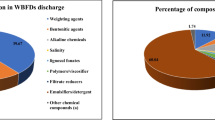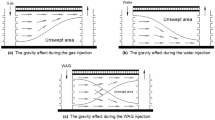Abstract
Evaluation of maximum content of water in natural gas before water condenses out at a given temperature and pressure is the initial step in hydrate risk analysis during pipeline transport of natural gas. The impacts of CO2 and H2S in natural gas on the maximum mole-fractions of water that can be tolerated during pipeline transport without the risk of hydrate nucleation has been studied using our novel thermodynamic scheme. Troll gas from the North Sea is used as a reference case, it contains very negligible amount of CO2 and no H2S. Varying mole-fractions of CO2 and H2S were introduced into the Troll gas, and the effects these inorganic impurities on the water tolerance of the system were evaluated. It is observed that CO2 does not cause any distinguishable impact on water tolerance of the system, but H2S does. Water tolerance decreases with increase in concentration of H2S. The impact of ethane on the system was also investigated. The maximum mole-fraction of water permitted in the gas to ensure prevention of hydrate formation also decreases with increase in the concentration of C2H6 like H2S. H2S has the most impact, it tolerates the least amount of water among the components studied.

Similar content being viewed by others
References
Hammerschmidt E. Formation of gas hydrates in natural gas transmission lines. Industrial & Engineering Chemistry, 1934, 26: 851–855
Kvamme B, Kuznetsova T, Bauman J M, Sjöblom S, Kulkarni A A. Hydrate formation during transport of natural gas containing water and impurities. Journal of Chemical & Engineering Data, 2016, 61 (2): 936–949
Dholabhai P D, Bishnoi P R. Hydrate equilibrium conditions in aqueous electrolyte solutions: Mixtures of methane and carbon dioxide. Journal of Chemical & Engineering Data, 1994, 39(1): 191–194
Barker J, Gomez R. Formation of hydrates during deepwater drilling operations. Journal of Petroleum Technology, 1989, 41(3): 297–301
Song G, Li Y, Wang W, Jiang K, Ye X, Zhao P. Investigation of hydrate plugging in natural gas + diesel oil + water systems using a high-pressure flow loop. Chemical Engineering Science, 2017, 158: 480–489
Sloan E D, Koh C A. Clathrate hydrates of natural gases. In: Chemical Industries. 3rd ed. Boca Raton: CRC Press, 2008, 11–12, 27–28
Jamaluddin A, Kalogerakis N, Bishnoi P. Hydrate plugging problems in undersea natural gas pipelines under shutdown conditions. Journal of Petroleum Science Engineering, 1991, 5: 323–335
Kumar S. Gas Production Engineering. Houston: Gulf Publishing Company, 1987, 1–646
John V, Holder G. Hydrates of methane + butane below the ice point. Journal of Chemical & Engineering Data, 1982, 27: 18–21
Ng H J, Robinson D B. Equilibrium-phase properties of the toluenecarbon dioxide system. Journal of Chemical & Engineering Data, 1978, 23: 325–327
Kvamme B, Tanaka H. Thermodynamic stability of hydrates for ethane, ethylene, and carbon dioxide. Journal of Physical Chemistry, 1995, 99: 7114–7119
Tzotzi C, Parenteau T, Gainville M, Sinquin A, Cassar C, Turner D, Greaves D, Bass R, Decrin M K, Larrey D, et al. Hydrate plug management full scale test: Hydrate plug dissociation in an electrically heated pipe in pipe. In: Proceedings of the 8th International Conference on Gas Hydrates (ICGH8-2014). Beijing, 2014
Makogon Y F. Natural gas hydrates—a promising source of energy. Journal of Natural Gas Science and Engineering, 2010, 2: 49–59
Zerpa L E, Aman Z M, Joshi S, Rao I, Sloan E D, Koh C, Sum A. Predicting hydrate blockages in oil, gas and water-dominated systems. In: Proceedings of Offshore Technology Conference. Houston, 2012
Carroll J J. Natural Gas Hydrates: A Guide for Engineers. 2nd ed. Amsterdam: Elsevier, 2009, 3–5
Babu P, Yang T, Veluswamy H P, Kumar R, Linga P. Hydrate phase equilibrium of ternary gas mixtures containing carbon dioxide, hydrogen and propane. Journal of Chemical Thermodynamics, 2013, 61: 58–63
Kvamme B, Aromada S A. Alternative routes to hydrate formation during processing and transport of natural gas with a significant amount of CO2: Sleipner gas as a case study. Journal of Chemical & Engineering Data, 2018, 63(3): 832–844
Kvamme B, Aromada S A. Risk of hydrate formation during the processing and transport of troll gas from the North Sea. Journal of Chemical & Engineering Data, 2017, 62: 2163–2177
Kvamme B, Kuznetsova T, Kivelæ P H, Bauman J. Can hydrate form in carbon dioxide from dissolved water? Physical Chemistry Chemical Physics, 2013, 15(6): 2063–2074
Kvamme B, Kuznetsova T. Kivelae P H. Adsorption of water and carbon dioxide on hematite and consequences for possible hydrate formation. Physical Chemistry Chemical Physics, 2012, 14(13): 4410–4424
Kvamme B, Iden E, Tveit J, Veland V, Zarifi M, Qorbani K. Effect of H2S content on thermodynamic stability of hydrate formed from CO2/N2 mixtures. Journal of Chemical & Engineering Data, 2017, 62(5): 1645–1658
Kvamme B, Førrisdahl O K. Polar guest-molecules in natural gas hydrates: Effects of polarity and guest-guest-interactions on the Langmuir-constants. Fluid Phase Equilibria, 1993, 83: 427–435
Kvamme B, Lund A. The influence of gas-gas interactions on the Langmuir constants for some natural gas hydrates. Fluid Phase Equilibria, 1993, 90: 15–44
Qin J, Kuhs WF. Quantitative analysis of gas hydrates using Raman spectroscopy. AIChE Journal. American Institute of Chemical Engineers, 2013, 59(6): 2155–2167
Bauman J M. Kinetic modelling of hydrate formation, dissociation, and reformation. Dissertation for the Doctoral Degree. Norway: University of Bergen, 2015, 13–14
Soave G. Equilibrium constants from a modified Redlich-Kwong equation of state. Chemical Engineering Science, 1972, 27(6): 1197–1203
Kvamme B, Kuznetsova T, Jensen B, Stensholt S, Bauman J, Sjøblom S, Lervik K N. Consequences of CO2 solubility for hydrate formation from carbon dioxide containing water and other impurities. Physical Chemistry Chemical Physics, 2014, 16(18): 8623–8638
Kvamme B, Qasim M, Baig K, Kivelä P H, Bauman J. Hydrate phase transition kinetics from phase field theory with implicit hydrodynamics and heat transport. International Journal of Greenhouse Gas Control, 2014, 29: 263–278
van der Waals J H, Platteuw J C. Clathrate solutions. Advances in Chemical Physics, 1958, 2: 1–57
Sloan E D. Fundamental principles and applications of natural gas hydrates. Nature, 2003, 426(6964): 353–363
Svandal A. Modeling hydrate phase transitions using mean-field approaches. Dissertation for the Doctoral Degree. Norway: University of Bergen, 2006, 9–24
Johansen G R. Optimization of offshore natural gas field development. Dissertation for the Master’s Degree. Norway: Norwegian University of Science and Technology, 2011, 6–7
Obanijesu E O, Pareek V, Tade M O. Hydrate formation and its influence on natural gas pipeline internal corrosion rate. In: SPE Oil and Gas India Conference and Exhibition. Mumbai: Society of Petroleum Engineers, 2010, doi.org/10.2118/128544-MS
Frost E M Jr, Deaton W M. Gas hydrate composition and equilibrium data. Oil & Gas Journal, 1946, 45: 170–178
Adisasmito S, Frank R J, Sloan E D. Hydrates of carbon dioxide and methane mixtures. Journal of Chemical & Engineering Data, 1991, 36(1): 68–71
Noaker L J, Katz D L. Gas hydrates of hydrogen sulfide-methane mixtures. Journal of Petroleum Technology, 1954, 6: 135–137
Robinson D, Hutton J. Hydrate formation in systems containing methane, hydrogen sulphide and carbon dioxide. Journal of Canadian Petroleum Technology, 1967, 6(10): 6–9
Sun C Y, Chen G J, Lin W, Guo T M. Hydrate formation conditions of sour natural gases. Journal of Canadian Petroleum Technology, 2003, 48: 600–602
John V, Papadopoulos K, Holder G. A generalized model for predicting equilibrium conditions for gas hydrates. AIChE Journal. American Institute of Chemical Engineers, 1985, 31: 252–259
Holder G, Hand J. Multiple-phase equilibria in hydrates from methane, ethane, propane and water mixtures. AIChE Journal. American Institute of Chemical Engineers, 1982, 28: 440–447
Dharmawardhana P, Parrish W, Sloan E. Experimental thermodynamic parameters for the prediction of natural gas hydrate dissociation conditions. Industrial & Engineering Chemistry Fundamentals, 1980, 19(4): 410–414
Ebbrell H K. The composition of Statoil (Norway) gas well. 1984, 1–26
Altfeld K, Schley P. Report: Gas Quality. Heat Processing, 2012, 3: 78–83
Kvamme B, Austrheim M, Knarvik A, Zarifi M. Hydrate formation during transport of natural gas containing water and impurities. International Journal of Engineering Research and Development, 2017, 13(5): 1–16
Kvamme B, Sapate A. Hydrate risk evaluation during transport and processing of natural gas mixtures containing ethane and methane. Research & Reviews. Journal of Chemistry, 2016, 5(3): 64–74
Schuchardt D, Krause D G G, Kulp D. Environmental Impact Assessment Europipe II in Germany: Offshore and Onshore Section. Bremen: Bioconsult Schuchardt & Scholle, 1998, 1–58
Author information
Authors and Affiliations
Corresponding author
Electronic supplementary material
Rights and permissions
About this article
Cite this article
Aromada, S.A., Kvamme, B. Impacts of CO2 and H2S on the risk of hydrate formation during pipeline transport of natural gas. Front. Chem. Sci. Eng. 13, 616–627 (2019). https://doi.org/10.1007/s11705-019-1795-2
Received:
Accepted:
Published:
Issue Date:
DOI: https://doi.org/10.1007/s11705-019-1795-2




